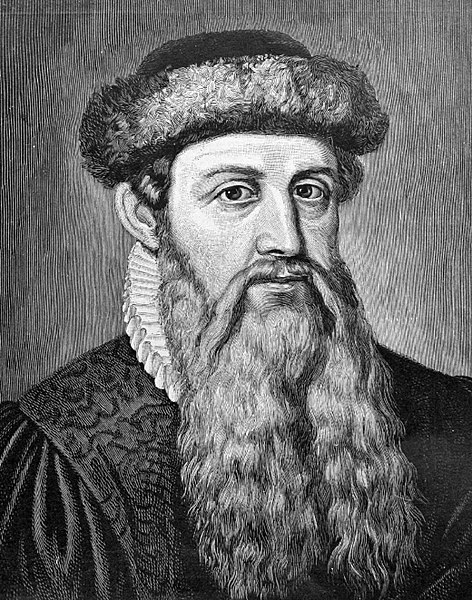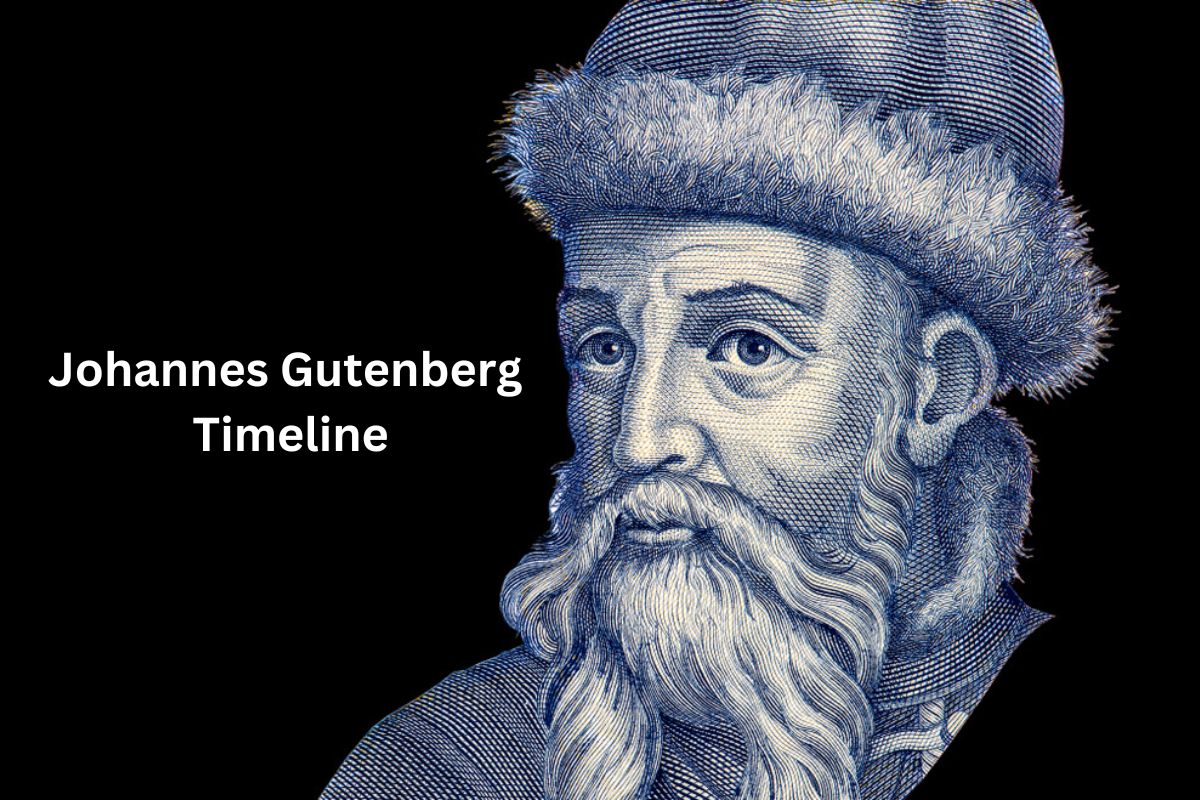Johannes Gutenberg was a German inventor and printer born around the year 1400 in Mainz, Germany.
He is best known for introducing the printing press to Europe in the 15th century. Gutenberg’s groundbreaking invention included movable metal type, an innovative oil-based ink, and a mechanical printing press.
His most famous achievement was the production of the Gutenberg Bible (also known as the 42-line Bible or the Mazarin Bible) in the mid-1450s, which is considered one of the first major books printed with movable type.
This marked the beginning of the Gutenberg era and had a profound impact on the dissemination of knowledge, culture, and religion in Europe.
| Year | Event |
|---|---|
| Circa 1400 | Johannes Gutenberg is born in Mainz, Germany. |
| 1428 | Gutenberg moves to Strasbourg and gains various skills. |
| 1430s | Gutenberg returns to Mainz and starts work on the printing press. |
| 1440s | Gutenberg refines his printing technology and develops movable type. |
| 1450s | Gutenberg completes the Gutenberg Bible, one of the first books printed with movable type. |
| 1455 | Gutenberg Bible is printed in Mainz, marking the start of the Gutenberg era. |
| 1457 | Gutenberg prints the Mainz Psalter, another significant work. |
| 1460s | Gutenberg faces financial difficulties and loses control of his workshop. |
| 1468 | Johannes Fust takes legal action and gains control of the workshop. |
| 1468-1469 | Gutenberg continues working on various printing projects in Mainz. |
| 1469 | Johannes Gutenberg dies in Mainz, Germany, at around 68 years old. |
| 16th Century | Printing press technology spreads rapidly throughout Europe. |
Timeline of Johannes Gutenberg
Circa 1400 – Johannes Gutenberg is born in Mainz, Germany.
Johannes Gutenberg’s exact birthdate is not known, but he was born around the year 1400 in Mainz, a city in what is now Germany.
His birthplace would later become a significant center for the development of printing technology.

1428 – Gutenberg moves to Strasbourg and gains various skills.
In 1428, Gutenberg left Mainz and relocated to Strasbourg (then part of the Holy Roman Empire, now in France).
Also Read: Johannes Gutenberg Accomplishments
During his time in Strasbourg, he engaged in various entrepreneurial activities and acquired valuable skills related to metallurgy and printing. These experiences would play a crucial role in his later work on the printing press.
1430s – Gutenberg returns to Mainz and starts work on the printing press.
By the early 1430s, Gutenberg returned to Mainz, his hometown. It was during this period that he began his groundbreaking work on the development of the printing press.
Also Read: Printing Press Facts
He experimented with movable type, a system where individual metal letters and characters could be arranged and rearranged to compose text. This innovation laid the foundation for his later inventions and the revolution of printing technology in Europe.
1440s – Gutenberg refines his printing technology and develops movable type.
During the 1440s, Johannes Gutenberg made significant advancements in the development of his printing technology. One of his most critical innovations was the creation of movable type.
He designed individual metal letters, numerals, and symbols that could be arranged and rearranged to compose text. This movable type made the printing process more efficient and allowed for the mass production of books and documents.
1450s – Gutenberg completes the Gutenberg Bible, one of the first books printed with movable type.
In the 1450s, after years of experimentation and refinement, Gutenberg achieved a major milestone by completing the printing of the Gutenberg Bible, also known as the 42-line Bible or the Mazarin Bible.
This Bible is considered one of the first major works to be printed using movable type and is a masterpiece of typography and printing. It marked a significant turning point in the history of printing and book production.

1455 – Gutenberg Bible is printed in Mainz, marking the start of the Gutenberg era.
The year 1455 is a historic moment in the history of printing. In this year, the Gutenberg Bible was printed in Mainz, Germany. This event is often regarded as the official beginning of the Gutenberg era and the spread of printing technology throughout Europe.
The Gutenberg Bible was a masterpiece of craftsmanship and played a vital role in disseminating religious texts and knowledge to a wider audience, contributing to the cultural and intellectual flourishing of the Renaissance.
1457 – Gutenberg prints the Mainz Psalter, another significant work.
In 1457, following the successful printing of the Gutenberg Bible, Johannes Gutenberg went on to produce another significant work, the Mainz Psalter.
The Mainz Psalter was a Psalter, a book of psalms from the Bible, and it demonstrated Gutenberg’s ability to apply his printing technology to a variety of texts. This work further showcased the potential of the printing press for producing books efficiently and accurately.
1460s – Gutenberg faces financial difficulties and loses control of his workshop.
Despite his pioneering work and the success of his printed books, Johannes Gutenberg faced financial challenges during the 1460s.
The production of printed books, especially the Gutenberg Bible, was an expensive endeavor, and Gutenberg struggled to recoup his investments. As a result, he encountered financial difficulties and mounting debts.
1468 – Johannes Fust takes legal action and gains control of the workshop.
In 1468, Johannes Gutenberg’s financial difficulties escalated when Johannes Fust, one of his financial backers, took legal action against him. Fust claimed that Gutenberg owed him a substantial sum of money.
The legal proceedings resulted in Fust gaining control of Gutenberg’s printing workshop and its equipment. This turn of events marked a challenging period in Gutenberg’s life, as he lost control of the very invention that had transformed the world of printing.
1468 – Johannes Fust takes legal action and gains control of the workshop.
In 1468, Johannes Fust, one of Gutenberg’s financial backers, took legal action against him. Fust claimed that Gutenberg owed him a significant amount of money due to unpaid loans and expenses related to the printing enterprise.
The legal proceedings were unfavorable for Gutenberg, and as a result, Fust gained control of Gutenberg’s printing workshop and its equipment. This marked a turning point in Gutenberg’s life as he lost control of his pioneering invention.
1468-1469 – Gutenberg continues working on various printing projects in Mainz.
Despite the loss of his workshop and equipment, Johannes Gutenberg did not abandon his passion for printing. He continued to work on various printing projects in Mainz, although under different circumstances.
Gutenberg’s post-dispute period was marked by innovation and collaboration with others in the printing industry.
1469 – Johannes Gutenberg dies in Mainz, Germany, at around 68 years old.
Johannes Gutenberg passed away in Mainz in 1469 at the age of around 68. Despite the challenges he faced in the latter part of his life, his invention of the printing press and movable type had already left an indelible mark on history.
Gutenberg’s legacy continued to grow in the years following his death, as the technology he pioneered transformed the way information was disseminated, sparking a revolution in communication and knowledge-sharing.
16th Century – Printing press technology spreads rapidly throughout Europe.
In the decades following Gutenberg’s death, the printing press technology he developed spread rapidly throughout Europe. Print shops were established in various cities, and books, pamphlets, and documents were produced in large quantities.
This dissemination of information had far-reaching consequences, including the spread of knowledge, the Reformation, and the blossoming of the Renaissance. Gutenberg’s invention laid the foundation for modern printing and played a crucial role in shaping the course of human history.
